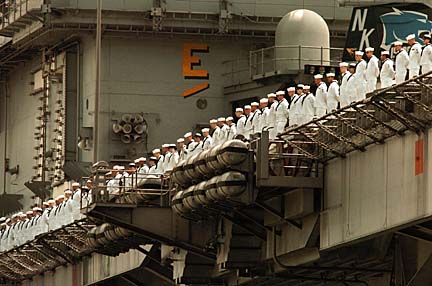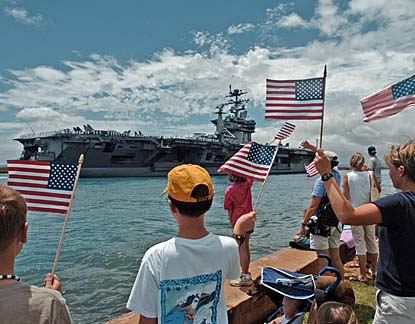
The USS Stennis arrived at Pearl Harbor yesterday, as sailors on board stood at attention. After spending the Fourth of July weekend in port, the carrier will head to sea on Monday to participate in this year's Rim of the Pacific war games.
Naval war games
target terrorismA U.S. admiral says the Pacific
maneuvers promote cooperation
The navies of Pacific nations need to continually train and work together because of the global war on terrorism, says the U.S. admiral who heads Rim of the Pacific, a seven-nation maritime war games.
Vice Adm. Michael McCabe told reporters yesterday, "Some 46,000 ships of various sizes pass through 4,000 ports, and frankly we don't have the greatest picture of what happens on the sea ... So I think it's very important, particularly in the Pacific, that the navies of the world get together and work together and can communicate well together as we focus on countering the terror threat, both in terms of the movement of weapons, people, drugs, illicit trade."
McCabe, commander of the Navy's 3rd Fleet, said this year's Rim of the Pacific naval war games bring to Hawaii waters 40 ships, seven submarines, and more than 100 aircraft from the maritime forces of Australia, Canada, Chile, Japan, South Korea and the United Kingdom. Observer nations include Ecuador, Malaysia, Mexico, the Philippines, Russia, Singapore and Thailand.
The biennial Pacific war maneuvers are being held as the U.S. Navy changes the way it deploys. Chief of Naval Operations Adm. Vern Clarke wants the Navy to be able to put six of its 12 carrier strike groups any place in the world within 30 days, with two more in ready reserve.Before the Sept. 11, 2001, terrorist attacks and the war in Afghanistan and Iraq, the Navy's deployment rotation was "very predictable, very precise where our forces arrived pretty much back-to-back right on time with a six-month deployment being the pattern," McCabe said.
"We wanted to be able to respond with our Navy more rapidly than we were set to do in the past."
The Fleet Response Plan, offered by Clarke, not only seeks to maximize training, manning and combat readiness, but also prove to allies and enemy forces that the U.S. Navy can provide a presence anywhere at any time, McCabe said.
Two years ago, the war in Afghanistan also trimmed back the number of RIMPAC participants to only eight nations, with allies like Canada sending over no ships.
This year, Canada has four ships, including one destroyer and one frigate, participating, said Commodore Roger Girouard, commander of the Canadian Pacific Fleet. "This year's RIMPAC for us is an opportunity ... in my case it's building a deployable task group. RIMPAC gives me the springboard to do that."
For the Australian navy, which has three ships and one submarine in the war games, Commodore Davyd Thomas said, "We do particularly want to hone our war-fighting skills, and the ability to communicate with other nations is important because if you can't communicate, you can't command."
After spending the Fourth of July weekend in port, the 18,000 RIMPAC participants will head to sea on Monday. Some of the events include the sinking of decommissioned ships, anti-submarine warfare, aircraft carrier flight operations, Marine amphibious assault at Bellows, and the test of a high-speed 300-foot aluminum catamaran that could transport almost 1,000 troops and 152 Humvees.
This year's war games will last through July 27.

